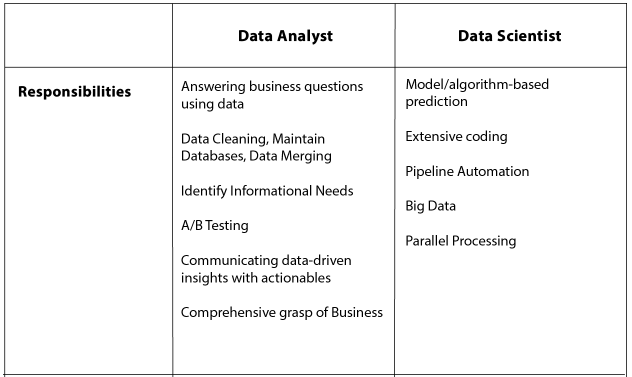
This article was originally published on .cult by Nate Rosidi. .cult is a Berlin-based community platform for developers. We write about all things career-related, make original documentaries and share heaps of other untold developer stories from around the world.
You’re a fresh graduate and you’re thinking of starting your career in a data-related role, but on the LinkedIn Jobs portal, you come across so many different job descriptions for data analyst, data scientist, business analyst, data engineer, machine learning engineer, the list goes on and on. You wonder which of these roles might be more appropriate for you, or if there’s even any meaningful difference between these different roles?
This article might just be the thing that can help clarify some of the key differences in these roles. We’ll be focusing on the differences between a data analyst and a data scientist.
A disclaimer, however, what’s covered in this article might not be entirely relevant to every data analyst or data scientist role, nor is it an exhaustive list of responsibilities you might face.
The truth is that these roles will differ between different companies and industries, and ultimately the best way of finding a good job fit is to spend time reading through the entire job description.


Data analyst responsibilities
As a data analyst, you will be heavily involved in using data to answer a variety of different business questions provided by various stakeholders in the company. To derive these answers, you will often find yourself engaged in several other tasks as part of the process.
For instance, many data analysts are involved in the acquisition of data from primary and secondary sources, as well as the data cleaning that follows from less structured datasets. In some instances, you’ll also be expected to work together with stakeholders to identify informational needs, which will then require you to design and maintain data systems and databases.
A data analyst can be expected to be heavily involved in A/B testing too. At times, data analysts must be creative in answering business problems that lack direct forms of data. This can involve going through different sets of data and merging them in ways that generate meaningful insights about consumers.
On the analysis front, the data analyst role is significantly more consulting-focused than that of a data scientist. Therefore, data analysts are more directly connected with stakeholders in business units and often serve as the communicative bridge for data scientists, given the complexities that may arise in the more technical elements of analysis.
In addition, data analysts are often more plugged into the client-facing elements of the business, and thus can sometimes be expected to assist with client pitches by providing analytical elements, or in creating dashboards to track and improve business performance.
What’s more important for a data analyst is to be able to derive actionable insights from datasets that help to answer real business challenges. For instance, as a data analyst, you might be asked to explain why the number of new users decreased in the previous month, or why a particular marketing campaign did better in certain regions. More importantly, data analysts need to be able to communicate these insights effectively to a variety of audiences, which often involves generating reports to communicate these insights and trends based on existing data.
The key priority for many data analysts lies in being able to translate these statistical insights into immediate action for the business. More generally, one unique experience of being a data analyst is that you will come to have a comprehensive grasp of the business as well as the wider industry. This is often necessary for the data analyst to generate meaningful insights that make sense to different stakeholders.
Data analyst coding skills & technical knowledge
You can expect many job descriptions for data analysts to include skills such as data mining, data warehousing and database management. Establishing data collection structures is also essential for future analysis that can be conducted on similar information sets, commonly used to track the performance of business decisions adopted in the past. SQL skills and database management skills are particularly crucial for data analysts as part of the insight generation process.
In terms of the skills involved, data analysts can expect to use quite a bit of SQL, Excel, R or Python, or SAS and BI software for a variety of purposes including statistical analysis, data modelling and data visualization.
However, unlike data scientists, data analysts are not primarily focused on advanced data modelling techniques. Instead, data analysts will mostly need to be familiar with basic supervised learning models like regression, with a good foundation in mathematics and statistics.
Data scientist responsibilities
Just like data analysts, data scientists work towards answering a particular business question that requires data-driven insight. However, data scientists are primarily concerned about estimating unknowns, using algorithms and statistical models to answer these questions. As a result, a key difference is the extent of coding employed in data scientist roles.
In this respect, data science roles can be challenging as they require a blend of technical skills and an understanding of business problems in context. A data scientist will often find himself or herself trying out different algorithms to solve a particular problem and might even have to be familiar with pipeline automation.
Data scientists also get their hands dirty with much larger sets of data than analysts do and are thus required to possess the skills to explore and model huge amounts of unstructured data, often in a parallel fashion using languages like Scala. Many data scientists eventually realize that a big part of their job involves just cleaning and processing raw data from a multitude of sources and making sure that this process can be replicated for actual deployment and prediction.
On the whole, while data analysts are more consulting oriented, data scientists are often more product-oriented, with the objective of creating data and modelling pipelines for efficient prediction in actual product environments with a high level of accuracy.
Data scientist coding skills & technical knowledge
On top of being proficient in SQL and Python or R, data scientists must be comfortable working in the cloud environment using software or languages such as Scala, Spark, Hadoop, AWS, Databricks, just to name a few.
To complement these skill sets, data scientists will also have to be familiar with OOP, Machine learning libraries, software development and more generally a thicker tech stack, as they may have to work with legacy scripts and algorithms that may even have to be updated as datasets change over time.
Because data scientists deal much more with prediction problems, they employ more advanced data techniques to make predictions that cater to both structured and unstructured data. Thus, not only is a solid foundation in mathematics and statistics necessary, but also comprehensive skills in data collection, processing, visualization, and most crucially, familiarity with Machine Learning algorithms.
Depending on the company, data scientists might find themselves getting exposure to a whole suite of algorithms in fields such as Natural Language Processing, Computer Vision and Deep Learning. As a result, data scientists are often required to have very strong backgrounds in statistics and frameworks such as TensorFlow.
Get the TNW newsletter
Get the most important tech news in your inbox each week.





